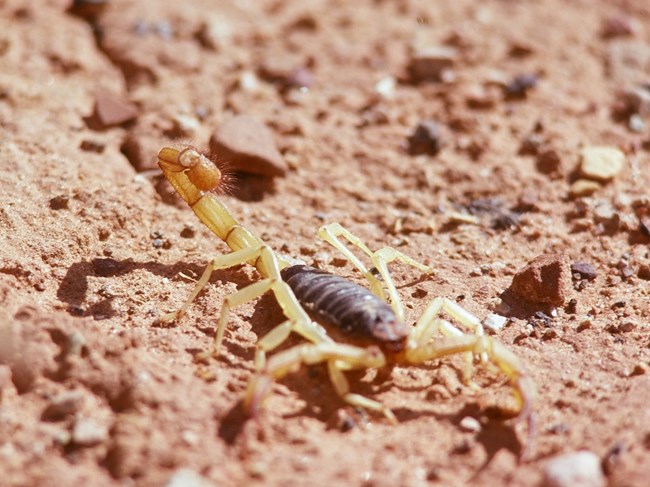|
Invertebrates are animals that lack a backbone. This group of animals includes, among other things, insects, spiders, crustaceans, worms, clams, squids, and corals. Most of the invertebrates at Capitol Reef are arthropods: invertebrates with exoskeletons, segmented bodies, and pairs of legs, which includes insects, spiders, scorpions, centipedes, and crustaceans. Arthropods are extremely diverse and plentiful. Around the world, about 1 million arthropod species have been named and described, but scientists estimate that there are likely 10 times more arthropod species that have yet to be discovered!

NPS / Emily Van Ness, Alicia Lafever Southwestern Tent Caterpillar MothThe southwestern tent caterpillar moth (Malacosoma incurvum) is a small brown moth with a wingspan of about 1 inch (27mm). The adult moths go largely unnoticed by park visitors, but their larvae garner much attention, largely because they create conspicuous silken sacks throughout the branches of the cottonwood trees (Populus fremontii) on which they feed. The caterpillars overwinter in eggs laid at tree branch junctions and emerge in spring. These blue fuzzy-looking caterpillars feed mainly on the leaves of cottonwood trees and take shelter during rest periods in large communal tents they construct. Tents are abandoned when heavily soiled and new ones are created.These caterpillars often emerge in great numbers in Capitol Reef, capable of defoliating entire trees! As a native species, tent caterpillars and cottonwoods have lived together for generations, and cottonwood trees have evolved the ability to refoliate (grow new leaves) after caterpillars stop feeding and retire to their cocoons. The fruit orchard trees do not have this adaptation, so park staff physically remove the caterpillars as needed. Caterpillars do not appear to be heavily preyed upon, but may be eaten by some bats and birds. After feeding for one to two months, the caterpillars will spend a day or two searching for a site and spinning their cocoon, usually in a narrow crack or under a ledge. After two to three weeks, they emerge as adults in the evening hours. As with most moths, they do not have functional mouths and cannot eat. They typically find a mate, lay their eggs, and die within a day, beginning the cycle anew.
Visit our keyboard shortcuts docs for details
Several tent caterpillars crawl in and around their silken tent in a cottonwood tree. 
Top: BLM / Vinison Fairy ShrimpFairy shrimp are small crustaceans that reside in ephemeral pools, also known as waterpockets. Capitol Reef is home to at least two species of fairy shrimp, the Greater Plains fairy shrimp (Streptocephalus texanus) and the versatile fairy shrimp (Branchinecta lindahli). Fairy shrimp typically have translucent bodies, but may exhibit a variety of faint colors depending on the food they eat. A typical fairy shrimp diet consists of algae, bacteria, protozoa, and dead organic matter. Predators include birds, amphibians, and large insects. Adults of most species measure 0.25 to 1 inches long (6 to 25 mm). They swim upside-down, propelled by eleven sets of legs, which move in a wave-like undulating motion.The fairy shrimp life cycle is short, lasting a few weeks or a few months, depending on the species. Females lay hard-shelled eggs (cysts) that can survive desiccation and freezing until spring runoff allows them to hatch. These eggs are incredibly durable, able to survive through years of drought and can even survive in the digestive system of animals. As such, they can easily be spread by animals. Invertebrates that inhabit ephemeral pools are often highly sensitive to pollutants. Keep your hands and feet out of these pools to prevent pollution from sunscreen, lotion, and bug spray that may be on your skin. 
NPS Black Hairy ScorpionThe black hairy scorpion (Hadrurus spadix) is the largest scorpion in Capitol Reef, with a length of about 5 inches (13 cm). It is easily distinguished from other scorpions in the area by its black body (cephalothorax). Its many hairs help it sense vibrations that may indicate the presence of prey and predators. They typically dwell underground in burrows that may contain intricate tunnels up to a few meters in length. This species is aggressive, attacking large insects, other scorpions, and even snakes and lizards.Capitol Reef's scorpions can deliver painful stings, but the toxicity of their venom is relatively low. The Arizona bark scorpion (Centruroides sculpturatus), which can be a serious threat to humans, is not found in the park and lives further south. 
NPS / Emily Van Ness Harvester AntsHarvester ants are in the genus Pogonomyrmex. There are several species of harvester ants in Utah, but they can be difficult to identify to the species level. These insects collect and store seeds in underground stashes, hence the name "harvester." They may also consume other insects, especially termites. To spot a harvester ant, first look for their distinctive mounds of small rocks ranging in size from 1 foot to several feet (0.3-1 m) in diameter.A colony begins with one winged female ant, the queen. She digs a small burrow and lays her eggs, which turn into wormlike larvae, and then pupae resembling small ants in a papery case. After several weeks, the adult ants emerge. The queen can live for more than 20 years and is the only reproductive member of the colony, laying thousands of ant eggs over her lifetime. After a few years, when the population is well established with thousands of individuals, the queen will give birth to several winged males and females who will leave the colony and may help establish new ones. Harvester ants can deliver a painful sting, but they are an important part of the ecosystem as seed dispersers and as a food source. Horned lizards (Phrynosoma hernandesi) appear to be immune to the ants’ stings, allowing them to consume the ants without pause.
Visit our keyboard shortcuts docs for details
Several reddish colored ants travel in and out of a small entrance to their underground dwelling. Some carry debris. |
Last updated: April 24, 2021
